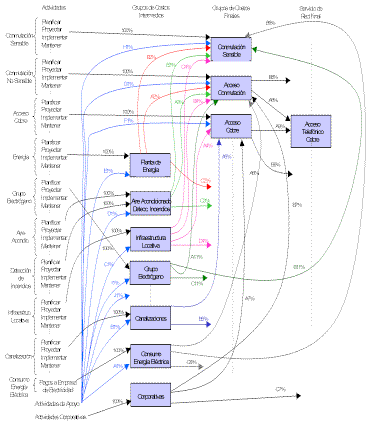|
This document describes a possible cost model for
these types of access, meaning that other such models may exist.
Models developed in this connection would be very similar. As has been
done above, we will discuss copper access and switched access
separately, recalling their earlier definitions:
The total costs of a service comprise the direct
and indirect costs associated with its operation plus the depreciation
of the assets used to provide the service.
Cost model structure
For a moment, let us leave aside depreciation of
company assets and examine the structure of the costs associated with
copper access and switched access.
Costs originate in source cost centers. A cost
center is a department, management office, or any other company
operational unit where company costs are actually generated. All
expenditure made by the company originates in cost centers.
The costs of each such center must be distributed
among a series of activities that are defined within the company.
The diagram below shows a model of costs associated
with copper access and switched access and, based thereon, how costs
associated with the types of telephone access are obtained.

We will now discuss some aspects of the cost model
presented in the above diagram to gain a better understanding of how
it is developed and the function of each of the components involved.
Cost center
As mentioned above, a cost center is any company
operational unit in which costs are generated.
In principle, all company costs are distributed
among the different cost centers, meaning that if the costs associated
with all cost centers are added together, total company expenditure
would be obtained. However, in reality, there are exceptions, as costs
such as payments made to the power company for power consumption are
not assigned to any cost center, these being assigned directly to an
intermediate cost group.
Activity
Once costs have been assigned to cost centers, each
center must distribute them among the different activities carried out
within the company. To do this, all activities carried out must be
identified.
The list of activities and corresponding
descriptions must include all relatively important tasks whose
existence is justified. This means that we will define an activity
such as “maintaining non-critical switching,” but we will not define
activities at lower levels, such as “changing subscriber module,” as
this activity is included within “maintaining non-critical switching,”
already defined.
Hundreds of activities may be defined within one
company. Activities directly related to the costs of copper access and
switched access usually include:
-
Planning copper access network
-
Designing copper access network
-
Implementing copper access network
-
Maintaining copper access network
-
Planning non-critical switching
-
Designing non-critical switching
-
Implementing non-critical switching
-
Maintaining non-critical switching
-
Planning power generating plant
-
Designing power generating plant
-
Implementing power generating plant
-
Maintaining power generating plant
-
Planning generator
-
Designing generator
-
Implementing generator
-
Maintaining generator
-
Planning ducts
-
Designing ducts
-
Implementing ducts
-
Maintaining ducts
-
Planning air conditioning system
-
Designing air conditioning system
-
Implementing air conditioning system
-
Maintaining air conditioning system
-
Planning grounds and buildings
-
Designing grounds and buildings
-
Implementing grounds and buildings
-
Maintaining grounds and buildings
-
Planning fire detection system
-
Designing fire detection system
-
Implementing fire detection system
-
Maintaining fire detection system
The above are examples of activities directly
related to the costs examined herein. Such activities may in turn be
subdivided by geographical area, multiplying them by the number of
geographical areas to be considered.
Many activities are included in those defined
herein as support activities. Examples are:
-
Training course coordination
-
Wage calculation and payment
-
Material resource procurement
-
Human resource recruitment
-
Relations with banking institutions
-
Cleaning service management
-
Transportation management
Corporate activities are a third group. These are
tasks related to the company’s corporate activities that are not
directly or indirectly related to the services provided. They include:
-
Activities related to the company’s board of
directors and general management
-
Activities related to the regulatory body and to
all other organizations–national and international
-
Corporate marketing tasks, that is, all aspects
of the company’s image as a whole
Drivers
When company costs have been distributed among its
different activities and cost groups defined, it must be determined
how activity costs are distributed among the different items (intermediate
groups, end groups, end network services, end customer services,
etc.).
Costs of activities are associated with
intermediate cost groups through the use of “drivers,” defined below.
Drivers indicate the percentage of the activity
that is assigned to the corresponding item. Some activities are
assigned entirely to a single item, as in the case of the activity
“planning copper access,” 100% of which is assigned to the “copper
access” end costs group. Other activities are distributed among more
than one item. The sum of the drivers corresponding to such activities
must always be 100%.
Support activities are distributed among very many
items. The above diagram assumes that such activities are distributed
among intermediate costs groups and the corporate group. They may,
however, be assigned to other types of item, which may include other
activities.
In some cases, it may be rather difficult to determine drivers. We
discuss below how this is done.
Aldo Castaña
Engineering and technology University
Catholic University of Uruguay
|
Additional Information: This document is part of the
material of the distance course "Cost and
evaluation of projects of network services " that will be held
on 2006 by the Regional Training Center and Node of the
Center of Excellence of the ITU: Engineering and technology
University - Catholic University of Uruguay. In
info @ CITEL Nr. 19 we included a first introduction. CITEL/OAS
offers 15 complete
fellowships of the registration fee of US$ 200.
Please download
here the announcement. These fellowships are subject to the availability of funds
corresponding to the 2006 OAS Regular
Budget.
|
|

